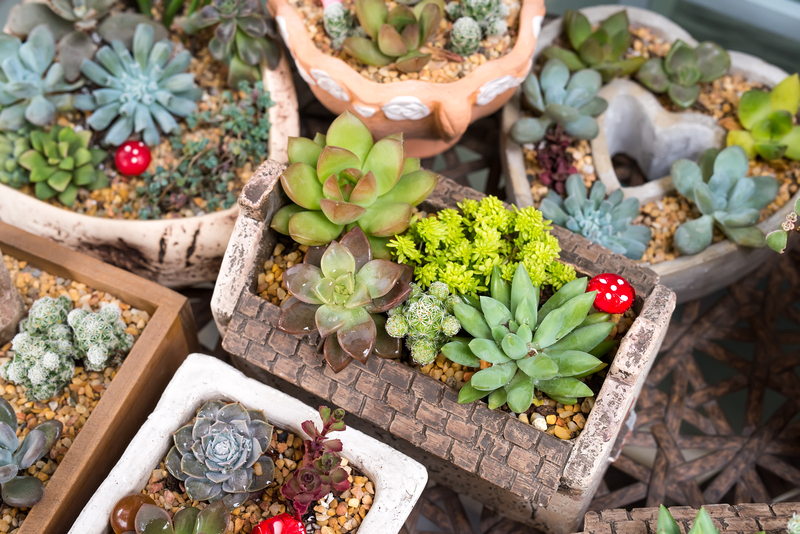Interactive Elements for a Captivating Child-Friendly Garden
Posted on 25/06/2025
Interactive Elements for a Captivating Child-Friendly Garden
A child-friendly garden can spark curiosity, foster creativity, and provide hours of enduring entertainment while nurturing a deep connection with nature. If you're planning to transform your outdoor space, adding interactive elements for children can turn an ordinary garden into a magical playland. In this comprehensive guide, we'll delve into the most engaging ideas and must-have features for designing an irresistible, safe, and fun garden tailored for kids.
Why Interactive Gardens Matter for Children
Children thrive through active play, exploration, and hands-on experiences. Interactive gardens not only provide joyful recreation, but also support crucial developmental milestones. Here's why incorporating child-centric features in your garden is so important:
- Sensory Development: Gardens awaken senses through colors, scents, textures, and sounds.
- Physical Activity: Features like climbing structures and paths encourage movement and exercise.
- Learning Opportunities: Growing plants and observing wildlife nurtures curiosity and environmental awareness.
- Imagination and Creativity: Nature-inspired play zones inspire storytelling, pretend play, and creative thinking.
- Social Skills: Shared garden spaces promote cooperation, communication, and teamwork.

Top Interactive Elements for a Captivating Kid-Friendly Garden
1. Sensory Paths and Discovery Trails
Sensory pathways are wonderful additions to any child-friendly garden landscape. Designed to delight touch, sight, and smell, they invite children to wander, observe, and explore.
- Texture Walkways: Create paths using varied materials like pebbles, wood rounds, grass, sand, or tiles, so children can feel the changes under their feet.
- Aromatic Borders: Plant herbs such as lavender, mint, and rosemary for scent-rich experiences. Encourage kids to pick and smell the leaves as they walk.
-
Unused gaps:Plant stepping stones with engraved animal footprints or numbers to provide both learning and playful discovery.
2. DIY Play Structures
Play equipment is a classic staple of child-centric garden spaces, but you can go beyond the standard swing set:
- Natural Play Structures: Use logs, stumps, and branches to build climbing frames, balance beams, or simple obstacle courses.
- Willow Teepees: Grow living playhouses out of willow or other flexible branches that form a shady den, fort, or secret hideout.
- Treetop Platforms: Install sturdy platforms or treehouses for imaginative play and a birds-eye view of the garden.
Encourage children to help design or build these areas, which makes the garden experience even more immersive and personal!
3. Water Play Features
Water fascinates children of all ages and can be safely included in many forms:
- Splash Pads and Streams: Recirculating splash pads offer safe, low-maintenance water play. Shallow pebble streams can be both decorative and interactive.
- Water Tables: For younger kids, raised water tables filled with cups, sifters, and floating toys promote sensory play and fine motor skills.
- Pond Dipping Zones: Install a shallow wildlife pond with clear edges for dipping nets and discovering tadpoles, aquatic insects, and plants.
Always ensure water features are age-appropriate and supervised. Use safety covers or alarms for deeper ponds when not in use.
4. Edible Gardens and Child-Sized Raised Beds
Growing food is a deeply rewarding and interactive experience for kids. Empower children to plant, water, harvest, and taste by giving them their own plot:
- Mini Raised Beds: Construct beds at child height, where they can dig, sow seeds, and watch their favorite herbs and veggies grow.
- Themed Gardens: Try a "pizza garden" (tomatoes, basil, peppers), a rainbow garden, or a berry patch to ignite enthusiasm.
- Edible Mazes or Tunnels: Plant tall beans or sunflowers in a labyrinth pattern for a magical walk-through snack trail.
5. Interactive Art and Musical Zones
Infuse your child-friendly garden with creative expression and sound:
- Outdoor Musical Instruments: Install weather-resistant drums, xylophones, or chimes that encourage rhythm and movement.
- Garden Art Stations: Provide a sheltered spot with paints, chalks, or clay for making nature-inspired art.
- Mosaic Stepping Stones: Let kids decorate stepping stones with colorful tiles or glass for personalized garden paths.
6. Wildlife Havens and Bug Hotels
Foster a love for wildlife with interactive garden features:
- Bug Hotels: Build or buy insect houses using bamboo tubes and pine cones to attract pollinators and beneficial bugs.
- Bird Feeders and Baths: Install easy-to-maintain wildlife feeders at kid-height for close-up bird watching.
- Observation Stations: Set up a log pile, wildflower patch, or butterfly corner, complete with magnifying glasses and notebooks for exploration.
Safety First - Essential Tips for Child-Friendly Garden Design
While designing an interactive child-friendly garden, it's vital to keep safety top-of-mind. Consider these essential guidelines:
- Non-toxic Plants: Choose only non-poisonous plants, and avoid prickly or allergenic species.
- Safe Surfaces: Use mulch, bark, or rubber tiles to cushion falls and prevent slips.
- Secure Boundaries: Install child-proof gates and clearly defined paths for visibility.
- Tool Safety: Store sharp tools and chemicals out of reach.
- Supervision: Always supervise play, especially around water or climbing areas.
Low-Maintenance Ideas for Busy Parents
You don't have to be a master gardener to maintain an engaging interactive garden for kids. Here are simple ideas to keep the landscape fun and manageable:
- Mulched Play Zones: Suppress weeds and minimize mowing with mulch around play equipment and paths.
- Drought-Tolerant Plants: Select hardy native species that thrive with minimal input.
- Sensory Pots: Group aromatic or tactile plants in containers for easy access and seasonal rotation.
- Perennial Edibles: Try strawberries, raspberries, or chives for effortless snacks year after year.
Involving Children in Garden Creation
A truly enchanted children's interactive garden is one built with its young users in mind. Engage kids in the planning, planting, and decorating process:
- Let Them Choose Themes: Whether it's dinosaurs, fairies, or outer space, tap into your child's interests for inspiration.
- Give Them Real Tasks: Involve children in digging, sowing, labeling plants, or watering their assigned patch.
- DIY Decor: Encourage them to paint rocks, make wind spinners, or hang handmade signs to personalize the space.
By inviting children into the process, you'll not only create a magical interactive garden but also memories that will last a lifetime.
Garden Design Checklist: Key Interactive Features
- Sensory pathways with changing textures and aromatic plants
- Nature-inspired climbing frames and obstacle courses
- Safe water play areas, such as splash pads or water tables
- Edible raised beds and themed planting beds just for kids
- Outdoor musical instruments and creative art spaces
- Wildlife observation stations with bug hotels and bird feeders
- Shaded reading nooks or willow dens for quiet play
- Personalized garden decor made by children

Sustainability and Eco-Friendly Tips
A sustainable interactive garden not only delights today but ensures a thriving ecosystem for the future. Try to:
- Compost food scraps: Teach children about recycling organic waste and enriching soil.
- Harvest rainwater: Use barrels to collect rain for watering plants.
- Support pollinators: Plant wildflowers, avoid pesticides, and choose pollinator-friendly varieties.
- Use recycled materials: Old tires, pallets, and bottles can become fantastic garden features.
Conclusion: Creating a Captivating Child-Friendly Garden
Building an interactive, engaging, and safe child-friendly garden is one of the most rewarding gifts you can offer growing minds. By thoughtfully integrating interactive garden elements -- from sensory paths to bug hotels -- you stimulate learning, ignite creativity, and foster a lifelong love for the outdoors. Remember, whether your space is large or small, there are endless ways to design an environment where children can imagine, discover, and thrive right in your backyard.
Ready to get started? Begin with just a few of these magical interactive features and watch your kid-friendly garden bloom into a wonderland. Happy gardening!

